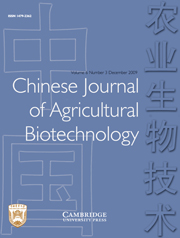No CrossRef data available.
Article contents
Genetic analysis of isozyme in Pteria penguin R. and offspring from inbreeding and hybridized stocks of Pinctada martensii D.
Published online by Cambridge University Press: 12 February 2007
Abstract
The genetic variation of isozymes [esterase (EST), superoxide dismutase (SOD), malate dehydrogenase (MDH), malic enzyme (ME) and glucose-6-phosphate dehydrogenase (G6PD)] extracted from two different adult tissues (adductor muscle and gill) of Pteria penguin R. and offspring from two stocks of Pinctada martensii D. were analysed by vertical polyacrylamide gel electrophoresis. The result showed an obvious and stable variation in the isozyme phenotypes in two different pearl oyster species. The SOD and EST isozymes from gill and MDH, ME and G6PDH from adductor muscle were species-specific. The electrophoretograms of these isozymes could be used as markers to differentiate the two pearl oysters. Between inbreeding and hybridized stocks of P. martensii, the electrophoresis patterns of isozymes were alike, but the similarities of electrophoretograms in the inbreeding progenies were higher than in the hybridized ones. The characteristic electrophoretograms of isozymes could be applied as molecular markers in the breeding of pearl oysters.
Information
- Type
- Research Article
- Information
- Copyright
- Copyright © China Agricultural University and Cambridge University Press 2006

